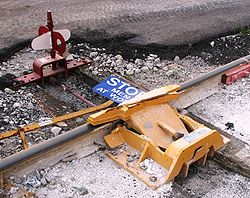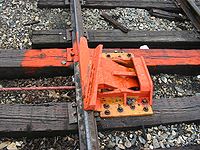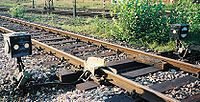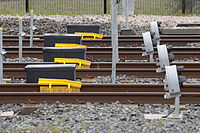- Derail
-
Not to be confused with Derailment.
A derail or derailer is a device used to prevent fouling of a track by unauthorized movements of trains or unattended rolling stock. It works (as the name suggests) by derailing the equipment as it rolls over or through the derail.
Although accidental derailment is damaging to equipment and track, and requires considerable time and expense to remedy, derails are used in situations where allowing equipment to proceed risks greater damage to equipment and potential injury or death may occur than if it is derailed at the spot.
Derails may be applied:
- where sidings meet main lines or other through tracks
- at junctions or other crossings to protect the interlocking against unauthorized movement
- at an area where crews are working on a rail line (via a portable derail device)[1]
- approaching a drawbridge, dead end, or similar hazard.
A derail device installed on a siding at Glen Haven, Wisconsin.
There are four basic forms of derail. The most common form is a wedge-shaped piece of steel which fits over the top of the rail. If a car or locomotive attempts to roll over it, the wheel flange is lifted over the rail to the outside, derailing it. When not in use, the derail folds away, leaving the rail unobstructed. It can be manually or remotely operated; in the former case it will have a lock applied to prevent it from being moved by unauthorized personnel. This type is common on North American railroads.
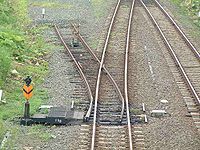 Derail on Nemuro Main Line, JR Hokkaido. It is set so that a train proceeding away from the camera will remain on the track.
Derail on Nemuro Main Line, JR Hokkaido. It is set so that a train proceeding away from the camera will remain on the track.
The second type of derail is known as the 'Split Rail' type (termed trap points or catch points in the UK). These are basically a complete or partial railroad switch which directs the errant rolling stock away from the main line. This form is common throughout the UK.
The third type of derail is the Portable Derail, and is used by railroad mechanical forces, as well as some industries. Often used in conjunction with Blue Flag rules and are temporary in nature.
The fourth type of derailer is the Powered or Motorized Derailer, electronically powered through an actuator this type is of derailer could be controlled remotely from an external control panel or manually. It is commonly installed as a part of Depot Personnel Protection Systems installed to ensure personnel safety in maintenance workshops and depots.
In North American practice, the normal position of a derail is in the derailing position (i.e. applied or left on).
Derails have failed on occasion, such as the Newark Bay rail accident of 1958, or on April 1, 1987 at Burnham, Illinois when an unsecured car in a siding defeated a derail and fouled the mainline. Due to rusty rails, the car failed to shunt the track circuit and put block signals to 'stop'.
See also
References
- ^ Meyer, J. Joe (March 9, 1978). "Portable derail". US Patent & Trademark Office. http://patft.uspto.gov/netacgi/nph-Parser?patentnumber=4165060. Retrieved September 25, 2006.
Categories:- Rail infrastructure
- Rail transport stubs
Wikimedia Foundation. 2010.

